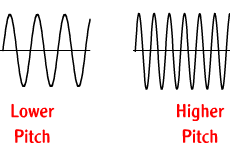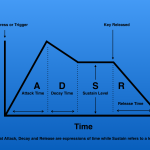Properties of Sound: Pitch
Pitch, also referred to as the tone of a particular note is measured in Hertz and designated a particular name corresponding to the musical scale of choice.
A pitch of A4 on the keyboard for example has a fundamental pitch of 440 Hz which is considered the universal tuning constant in the Western Musical scale.
Some cultures believe in using 432 Hertz(A4) as the universal constant for tuning the scale which then changes the pitch value of each corresponding note in the scale ever so slightly.
Hertz determines the number of times the signal cycles per second. Sounds cycling at a slower rate are percieved as lower, while those cycling faster are said to have a higher pitch.

The same note on a higher octave will have a ratio of exactly 2:1 to the note on the preceding octave, for example A4 will have a pitch or tone of 440 Hz, while A5 will have a pitch of 880 Hz and so on.
The reason an octave is percieved as one of the perfect intervals is due to its correspondence to a more stable ratio as seen above.
It isn’t always clear on viewing a spectrum analyser if the signal is a single pitch with heavier overtones or if multiple pitches are being played simultaneously to create overt harmonics. In determining the same, your ear is the best guide.
Tone is also used to refer to the texture of the individual sound and refers to its character as we learned in our previous article, a single note on various instruments can have a varying character depending on it’s overtones and undertones.
Another common perfect pitch interval used, is the 3:2(perfect fifth) interval, the best example of this would be any of Stephan Bodzins basslines, where he tunes two oscillators a fifth apart, creating a rich and dense tone.
Next week we’ll be looking at Amplitude and itsit’s corresponde to the properties of sound.





